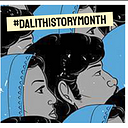Dalit Writers: Many Firsts in Movement Culture Work
by Aashika Shivangi Singh
Oppressor caste elites have dominated history and this has been documented as literature, manuscripts and even historical monuments. In particular, Brahmins dominated the formal knowledge sector. Only they had rights to read, write, teach the Vedas and other literary works so they wrote their own history, culture in literary art forms.
Against this knowledge domination, the people of the oppressed castes, and particularly, “untouchables” came up with their own literature, literary styles which in contemporary times knows as Dalit Literature. The literature which raises the voice of the oppressed. It is about their lives, experiences and vision.
The term “Dalit Literature” was first used at the first conference namely Dalit Sahitya Sammelan held by Maharashtra Dalit Sahitya Sangha (Maharashtra Dalit Literature Organisation) in the leadership of Annabhau Sathe in 1958 in Mumbai.
Although the literature has been written by oppressed people got the exact word “Dalit Sahitya or Dalit Literature” for their writings in 1958, when we trace the history of these writings, we find the origin of Dalit writing can be traced back to the bhakti movement during which poets such a Chokhamela and Karmamela became popular.
One of these early Dalit Bhakti writers was Madara Chennaiah, 11th century cobbler saint who lived during the reign of the western Chalukya and who is also regarded by some scholars as the “father of vachana poetry’’, which was a form of remembered poetry and sayings developed in 12th century C.E in Karnataka.
For instance, he wrote the following vachana depicting how “upper” race or birth can’t be an assurity of good deeds.
“If words and deeds are firm
There is no pollution of race or birth.
If words are good and deeds are bad, that is pollution without liberation.
Righteousness is high caste, unrighteousness in pollution.”
Modern Dalit literature emerged from the decade of 1960’s first in Marathi language and it soon appeared in Bangla, Hindi, Punjabi, Kannada, Tamil and Telugu languages through narratives such as poems, short stories and autobiographies. This all could be said to be the response to seeing seeing that the writers of mainstream literature didn’t give proper space to Dalits and their lives in their writings.
In Maharashtra, Dalit literary movement sprouted in its formal form with the emergence of Little Magazine Movement in Maharashtra. When youth got access to education, they chose to be writers and challenged the monopoly of oppressor-caste literature and it’s figures by publishing and promoting little magazines in Marathi language about anti-casteism.
The Dalit Panthers Movement too was too rooted in a literature for the masses. Dalit panthers are an Ambedkarite social organisation that seeks to combat caste discrimination. The organisation was founded by Namdeo Dhasal, Arjun Dangle, Raja Dhale, JV Pawar on 29 May 1972 all literary figures from the Dalit community.
In the 1970’s, Poet Namdeo Dhasal came up with his first poems collection Golpitha, in which he showed his anger against the oppression. And then Kamathipura which literally shook the roots of Brahmin writers because Dhasal’s literary style was absolutely unique. For the first time in the literary world, someone was writing on caste, eroticism, suppression and other taboo subjects. For example, in the Kamathipura poems collection, Dhasal wrote one of these poems mentioning Kamathipura, the red light area of Mumbai.
There were other literary figures such as Sharan Kumar Limbale, Bama, Basudev Sunani, P.Sivakami, Poomani, Narayan Surve, Annabhau Sathe, Omprakash Valmiki and others who were active participants of the movement. They were organizing gatherings, presenting plays and singing in the local dialect. They were very engaged to awaken the people against caste, gender oppression, to claim one’s identity in whatever form people wanted, to claim space in the mainstream, to make a separate path for the oppressed.
Soon this movement spread to other languages and parts of the country. It came to North, when Dalit writers and publishers started their own publishing houses. Omprakash Valmiki is the notable writer from Hindi belt who immensely contributed to Dalit literary movement for North. He came up with his own autobiography, Joothan and other poems, collection books, stories. When Omprakash Valmiki’s poems and stories came into picture, his literary style was to claim one’s own space and show the audience the reality of casteist society where oppressed-caste people were abused using words and atrocities.
In “Towards an Aesthetic of Dalit Literature” Sharankumar Limbale questions — why presenting “extraordinary pain” should not be considered as a standard of literature if providing “extraordinary pleasure” is considered beautiful and standard. It is the true portrayal of Dalit lives which adds literary values to Dalit Literature, but sadly often is dismissed as “artless”. This kind of criticism was seen from writers like NS Phadke, “the lives of Dalits and events that follow in their lives are not worthy of showcasing through novels”. But writers like Limbale have fought against such short-sighted analyses.
Dalit literature work is a kind of culture work. Writing, especially with pain, requires labour physically, socially, mentally and psychologically. And it is labour that bears serious outcomes. Dalit literature movement did only not challenged the established Brahminical way of writing which was dominated by god’s praise, ruler’s praise, masculinity, and casteism. On the other hand, it awakened the people from the oppressed sections about their social position and how to come up with dignity to claim one’s own space in this society.
Aashika Shivangi Singh is the independent writer based in Mathura, Uttar Pradesh. She is currently a Bachelor’s student at Miranda House College, Delhi University. She is interested in covering anti-caste and literary issues.
